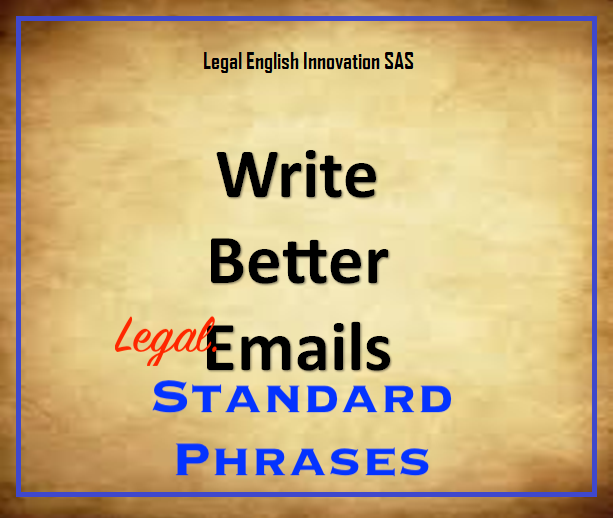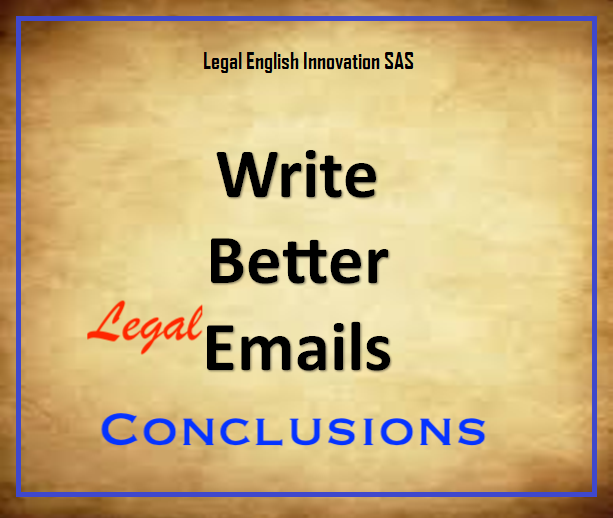Write Better (Legal) Email Introductions
Can you write a professional email?
Professional does not necessarily mean formal. It does not matter if you write formal or informal, just keep it the consistent.
This is the first rule to sounding “normal”, and it is almost automatic for native writers. You must focus on keeping the “register” (which is the way to say formal or informal) or what people think is similar to the tone of the email the same.
There is nothing more annoying and unprofessional than an email that is mixed and matched and sounds like it was written by a motley crew, rather than a professional.
Each week we will take a quick quiz in order to do a pre-check on your skills. It just takes 5 minutes and will help identify your weaknesses and show you where to focus.
10 Tips to Keep in Mind
Write with the Right Register & Tone
Open with an Appropriate Greeting
Focus on the Overall Email Purpose
Organize Emails Appropriately
Use Proper Email Spacing
Use Appropriate Language – Minimal Legalese
Never Email in Anger
Send Error-Free Emails
Close Politely with a CTA
And 1 more just for the lawyer…
Assume everything in the email will “end up in front of the judge“.
Free Audio Book from our Partners at Amazon
Click below
In today’s fast-paced, competitive business environment, we all need to communicate clearly and use our time productively. Even seasoned writers will find tips, tools, and ideas in this book that can improve the quality – and reduce the quantity – of email in the workplace. This book will help you write concise, clear emails that advance your business needs:
- Explore how social media is and is not a helpful guide for business email
- Use email to improve project management as a team leader or team member
- Adapt email for mobile devices and keep attachments user-friendly
Let the Harvard Business Review help you.
Check it out on our partner Amazon.
How to talk about the future.
will vs going to
Will
Will is your best intention. It is what you plan to do, but is not certain, or completely in your control.
Ex. I will have lunch this afternoon and then look at the report. (you certainly do not have a lunch date)
Ex. I will take a break when I finish the analysis. (not sure about the break)
Going to
Going to is certain. Something planned and in your control and command.
Ex. I am going to have lunch at 3pm at the Marriott.
Ex. The client is going to arrive at 2pm to sign the papers.
Will & Going to
The best of both worlds – Combining them. Something planned and the the hopeful result.
Ex. I am going to have lunch at 3pm and I hope it will be delicious.
Ex. The client is going to arrive at 2pm and I think he will sign the papers.
The Subject Line
When writing an email, it’s important to use an informed, detailed subject line. When a reader sees the subject line, the wording should immediately reveal what the message is about.
They don’t read it, they see it.
Average 7-10 words.
Additionally, it should contain enough of the message that it includes an expression or a term the recipient could search for if they need to find the email again.
The Introduction
We will break the introduction down into several steps. Let’s get ready to write, but whatever you do, keep the register consistent: formal or informal.
Step 1. The Greeting
How you greet your reader is especially important in setting the register (How formal will the email be?) in your writing. Here are some ways that are appropriate.
Informal
Hi John,
Hi there,
Hi everyone,
Formal
Hello Mr. Fazio,
Greetings,
Dear Mr. Fazio,
Step 2. Well Wishes
This part really is more of a formality, but be sure to match the register and follow the tone of your greeting (step 1.).
Informal
Hope all is good.
Hope you had a great weekend.
It is me again.
Formal
I hope this letter finds you well.
I hope you are doing well.
Step 3. Reason for Writing
Next, we need to inform the reader why we are writing. There are usually 3 reasons. One, you initiate the email. Two, you have to reply to a request, or three, you have to follow up on a previous matter. Take a look at some of the examples here. If you initiate the email with a request, use the phrases shown here. However if you are replying or following up, jump to the section below.
Informal
I would like to let you know that…
I am happy to say that…
Just letting you know…
Formal
I am writing in regards to the…
With reference to our…
It is a pleasure to inform you that…
Step 4. Replies and Follow ups
Now, you will need to think about how to organize the body and keep a consistent register and tone to your writing. Down below we will cover some tips and key phrases involved in managing a reply or a follow up.
Replies
Informal
Thanks for getting back to me.
Thanks for getting in touch.
Thanks for the quick response.
Formal
Thank you for the update.
Thank you for the information.
Thank you for the prompt response.
Follow Ups
Informal
Just following up on…
I am getting back to you on…
Just wanted to touch base on…
Formal
As per our conversation…
I would like to follow up on…
As we discussed on our call…
Phrasal Verbs
To kick off
To tip off
To tee off
What do these all have in common?
They all mean to start.
Ex. The meeting will kick off at this afternoon around 4pm.
Ex. I hope we will tip off and then move through the meeting quickly.
Ex. The committee is going to tee off at 11am.
Let’s kick off with an event invitation.
Can you find the 10 mistakes below?
It is an honor.
We would like to invites you to celebrate the 50th anniversarys of the founding of ours firm’s library. 2020 make the half century marks for legal learners in the library.
We will gets together in the atrium at 5pm, please bring your company ID, and dress jacket and tie attire. Please bring along a photo that you have of yourself and your friends that was takens in the library.
Our goal will be to shows everyone who has contributed to building this wonderful place, what lies ahead in the launch of our new masters plan!!
See you soon!
Answers below
It is an honor.
We would like to invites you to celebrate the 50th anniversaries of the founding of ours firm’s library. 2020 makes the half century marks for legal learners in the library.
We will gets together in the atrium at 5pm, please bring your company ID, and dress, jacket and tie attire. Please bring alongs a photo that you have of yourself and your friends that was takens in the library.
Our goal will be to shows everyone who has contributed to building this wonderful place, what lies ahead in the launch of our new masters plan!!
See you soon!
The W Questions – Brainstorming
Begin by listing all the information you need to include in your business event invitation wording, including the 5 W’s:
Who
(Who is hosting the event? This could be your company, a division in your company, or a manager, employee, or owner)
What
(What is the name of the event?)
When (When will the event be held? Include the date and time)
Where
(What is the address of the event? Will it be held in a specific area, such as the cafeteria or auditorium?)
Why
(Why is the event being held?)
You’ll need to work each of these into your invitation text to make it easy for your guests to understand why they should attend your event, when it is, and how to get there. Your invitation wording will also need to include any additional information, such as:
Special offers or incentives
Event schedule
Whether attendees are allowed to bring guests
Anything attendees should bring
Attire (formal or casual, if it’s not evident in the event description)
Catering information (list your menu if the event is catered; if guests have different menu options, let them choose via RSVP)
RSVP information (should they respond via mail, phone, online, text, etc.?)
Once you’ve listed the information you need to include, you can start writing your event invitation wording.
Let the Harvard Business Review help you learn to listen with free audio books from our partner Amazon.
Did you know?
Fun Email Facts
The first email was sent in 1971.
The first email sent from space was in 1991 by the Atlantis crew.
About 62% of your inbox is spam.
Hotmail was the first public use system and released in 1996.
There are about 4 billion active email addresses in the world.
Employees spend about 1/3 of their day attending to emails.
About 269 billion emails are sent per day.
The average office worker sends about 40 emails per day.
The average office worker receives about 120 in their inbox.
The subject line length for highest read rate is 61-70 characters (or about 7-10 words).
What they say…
Quotes from some famous users…
“We need to protect the privacy rights of all Americans, and that means stopping the federal government from spying on the cellphones and emails of law-abiding citizens.”
-Ted Cruz
“If an NSA, FBI, CIA, DIA, etc analyst has access to query raw SIGINT databases, they can enter and get results for anything they want. Phone number, email, user id, cell phone handset id (IMEI), and so on – it’s all the same.”
-Edward Snowden
“Hillary Clinton was asked if she wiped the disc she was using for her email; she said, ‘Do you mean with a damp cloth?’ This, to me, is frightening.”
-John McAfee
“The major advances in speed of communication and ability to interact took place more than a century ago. The shift from sailing ships to telegraph was far more radical than that from telephone to email!”
-Noam Chomsky
“Airplanes are a good place to concentrate because you get no emails, no phone calls.”
-Abraham Lincoln
Do you have a full, professional fluency in Legal English? Take our quiz below.
See your level in just 5 minutes.
We can teach you legal English.
Study technical grammar to improve your professional level.
Problems with Powerpoint?
Learn to make beautiful PowerPoints in minutes.
About the Author
Eric Froiland
Eric is a legal English teacher from the United States and has been based out of Bogota, Colombia for the last 10 years. He is the owner and founder of Legal English Innovation SAS, which is recognized as the top legal English academy in Colombia and is an official Test of Legal English Skills (TOLES) examination center.


